1994 PONTIAC GRAND-AM oil
[x] Cancel search: oilPage 210 of 274
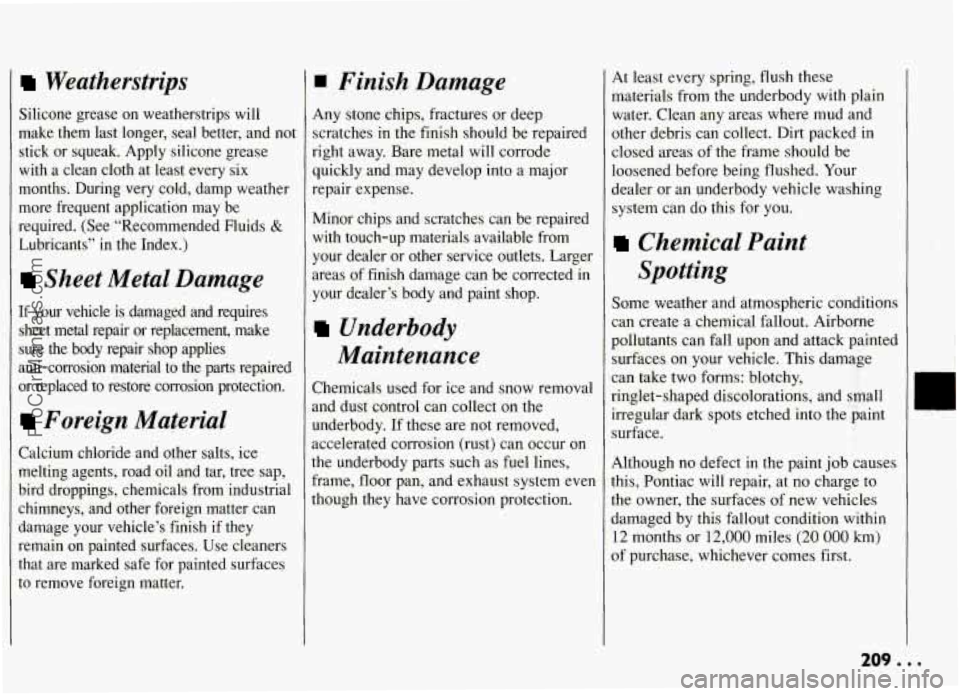
Weatherstrips
Silicone grease on weatherstrips will
make them last longer, seal better, and not
stick or squeak. Apply silicone grease
with
a clean cloth at least every six
months. During very cold, damp weather
more frequent application may be
required. (See “Recommended Fluids
&
Lubricants” in the Index.)
Sheet Metal Damage
If your vehicle is damaged and requires
sheet metal repair or replacement, make
sure the body repair shop applies
anti-corrosion material to the parts repaired
or replaced to restore corrosion protection.
Foreign Material
Calcium chloride and other salts, ice
melting agents, road oil and tar, tree sap,
bird droppings, chemicals from industrial
chimneys, and other foreign matter can
damage your vehicle’s finish
if they
remain on painted surfaces. Use cleaners
that are marked safe for painted surfaces
to remove foreign matter.
Finish Damage
Any stone chips, fractures or deep
scratches in the finish should be repaired
right away. Bare metal will corrode
quickly and may develop into a major
repair expense.
Minor chips and scratches can be repaired
with touch-up materials available from
your dealer or other service outlets. Larger
areas of finish damage can be corrected
in
your dealer’s body and paint shop.
Underbody
Maintenance
Chemicals used for ice and snow removal
and dust control can collect on the
underbody. If these are not removed,
accelerated corrosion (rust) can occur on
the underbody parts such as fuel lines,
frame, floor pan, and exhaust system even
though they have corrosion protection.
At least every spring, flush these
materials from the underbody with plain
water. Clean any areas where mud and
other debris can collect. Dirt packed in
closed areas
of the frame should be
loosened before being flushed. Your
dealer or an underbody vehicle washing
system can do this for you.
Chemical Paint
Spotting
Some weather and atmospheric conditions
can create a chemical fallout. Airborne
pollutants can fall upon and attack painted
surfaces on your vehicle. This damage
can take two forms: blotchy,
ringlet-shaped discolorations, and small irregular dark spots etched into the paint
surface.
Although no defect in the paint job causes
this, Pontiac will repair, at no charge to
the owner, the surfaces of new vehicles
damaged by this fallout condition within
12 months or 12,000 miles (20 000 km)
of purchase, whichever comes first.
C
209
ProCarManuals.com
Page 216 of 274
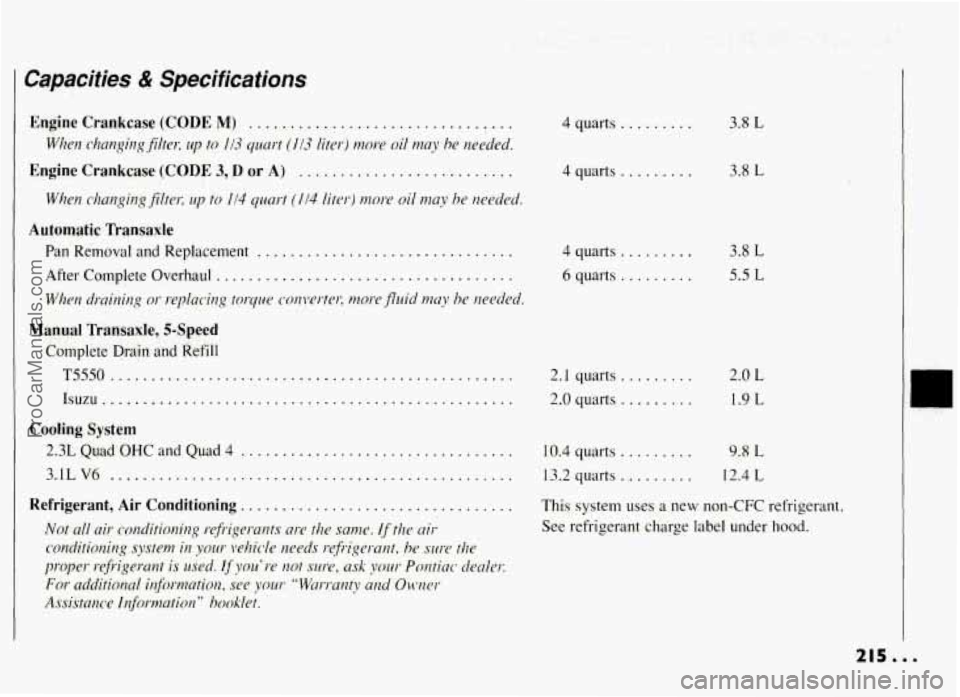
4quarts .........
4 quarts ......... 3.8 L
6 quarts ......... 5.5 L
Capacities & Specifications
Engine Crankcase (CODE M) ................................ 4 quarts ......... 3.8 L
When changing filter; up to /I3 quart (113 liter) more oil may he needed.
Engine Crankcase (CODE 3, D or A) ........................ . 3.8 L
When changing filter; up to 114 quart (114 liter) more oil may be needed.
Automatic Transaxle
Pan Removal and Replacement ...............................
After Complete Overhaul ....................................
When draining or ~-eplat*ing torque conl~erte~; more fluid may be needed.
Manual Transaxle, 5-Speed
Complete Drain and Refill
T5550 ................................................. 2.1 quarts ......... 2.0 L
Isuzu .................................................. 2.0quarts ......... 1.9 L
Cooling System
2.3L Quad OHC and Quad 4 ................................. 10.4 quarts ......... 9.8 L
3.1L V6 ................................................. 13.2 quarts. ......... 12.4 L
Refrigerant, Air Conditioning. ................................ This system uses a new non-CFC refrigerant.
Not all air conditioning refrigerants are the same. If the air See refrigerant charge label under hood.
conditioning system in your rvhic-le needs re$-igerant, he suse the
proper refrigerant is used. If you’re not sure, ask your Pontiac dealer,
For additional info)-mation, see your “Warranty and 0wwc.r
Assistance Information’’ hooklet.
215...
ProCarManuals.com
Page 221 of 274

Service & Appearance Care
Normal Maintenance Replacement Parts
Air Cleaner Element
2.3L Quad OHC and Quad 4 ....................
3.lLV6 ....................................
Engine Oil Filter
2.3L Quad OHC and Quad 4 ....................
3.1LV6 ....................................
PCV Valve
3.1LV6 ....................................
Spark Plugs
2.3L Quad OHC ..............................
2.3L Quad DOHC with Automatic Transaxle .......
2.3L Quad DOHC with Manual Transaxle .........
2.3L Quad High Output ........................
3.1LV6 ....................................
AC Type A- 1233C
AC Type A-1233C
AC Type PF- 1225
AC Type PF-40
or AC Type PF-47
AC Type 892C
AC Type 041-603
Gap: 0.035 inch (.889 mm)
AC Type 04 1-603
Gap: 0.035 inch (.889
mm)
AC Type 041-602
Gap: 0.035 inch (389 mm)
AC Type 04 1-602
Gap: 0.035 inch
(.889 mm)
AC Type R44 LT SM6
Gap: 0.060 inch (1.52 mm)
... 220
ProCarManuals.com
Page 224 of 274

IMPORTANT:
KEEP ENGlNE OIL
AT THE PROPER
LEVEL AND CHANGE AS
RECOMMENDED
1 This part covers the maintenance
I required for your Pontiac . Your vehick
needs these services to retain its
1 safety. dependability and emission
control performance
.
.... - .,. ....... ..
Have you purchased the
GM Protection Plan?
The Plan supplements your new vehicle warranties
.
See your Pontiac dealer for details .
Part 7
Maintenance Schedule
Introduction
A Word About Maintenance ..................................... 224
Your Vehicle and the Environment
................................ 224
How This Part
is Organized ..................................... 224
Using Your Maintenance Schedules . . ...................... 225
Selecting the Right Schedule
.................................... 225
Schedule1
................................................... 226
Schedule11
.................................................. 228
Explanation
of Scheduled Maintenance Services ................... 230
At Each Fuel Fill ............................................. 232
At Least Once a Month ......................................... 233
At Least Once a Year
.......................................... 233
AtLeastTwiceaYear
.......................................... 233
C . Periodic Maintenance Inspections ................................ 236
D . Recommended Fluids & Lubricants ................... ~ ......... 238
E . Maintenance Record .............................
~ ...... 240
A . Scheduled Maintenance Services
B . Owner
Checks & Services
223
ProCarManuals.com
Page 229 of 274
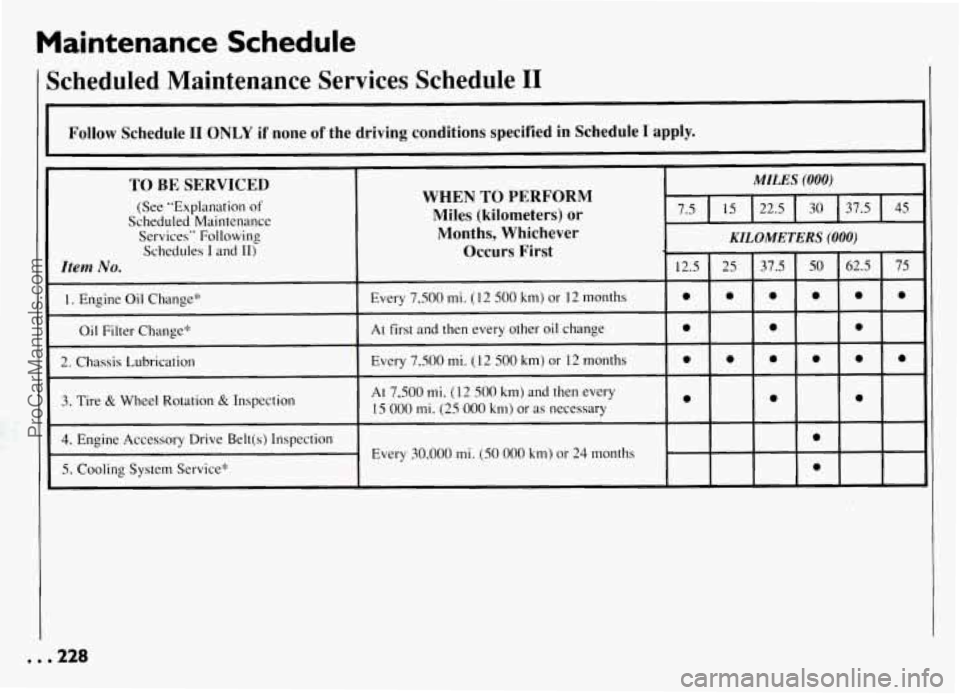
Maintenance Schedule
Scheduled Maintenance Services Schedule I1
Follow Schedule I1 ONLY if none of the driving conditions specified in Schedule I apply.
I
TO BE SERVICED
(See "Explanation of
Scheduled Maintenance Services" Following Miles (kilometers) or
Months, Whichever
KILOMETERS (000)
MILES (000)
WHEN TO PERFORM
Schedules I and 11,- Occurs First
Item No. 37.5 25
12.5
1. Engine Oil Change" Every
7,500 mi. ( 12 500 km) or 12 months
0,il Filter Change"
2. Chassis Lubrication At
first and then every other oil change
Every 7,500 mi. (12
500 km) or 12 months
0 0 0
0 0
0 0
0
3. Tire & Wheel Rotation & Inspection
4. Engine Accessory Drive Belt(s) Inspection
5. Cooling System Service*
At 7,500 mi. ( 12 500 km) and then every
15
000 mi. (25 000 km) or as necessary 0 0
Every 30.000 mi. (50 000 km) or 24 months
!
+
50 62.5
1
I
I.
t
. . .22a
ProCarManuals.com
Page 231 of 274
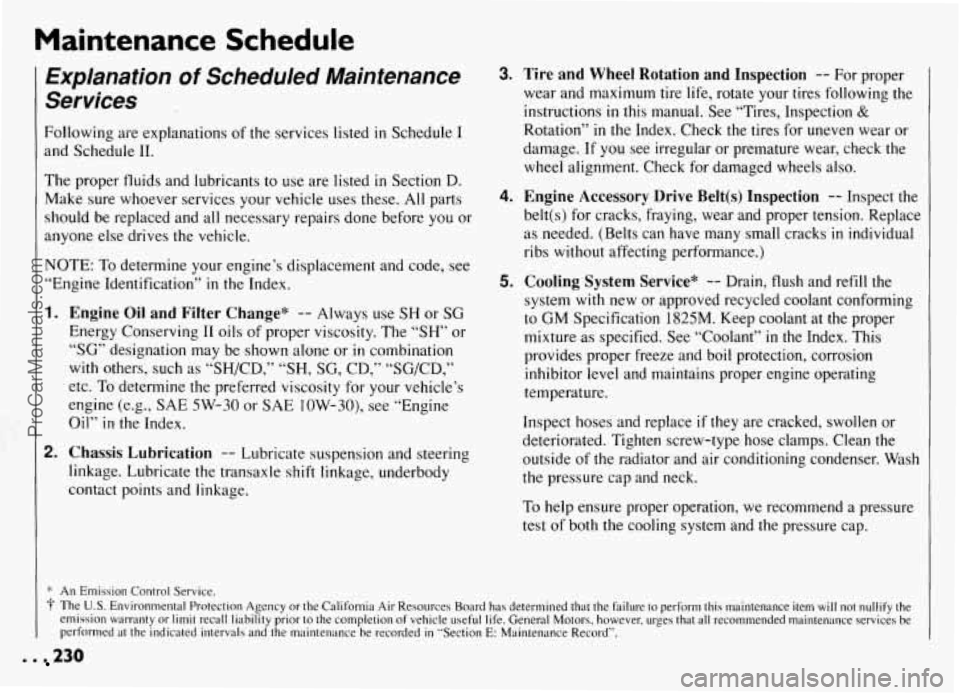
Maintenance Schedule
Explanation of Scheduled Maintenance
Services
Following are explanations of the services listed in Schedule I
and Schedule 11.
The proper fluids and lubricants to use are listed in Section D.
Make sure whoever services your vehicle uses these. All parts
should be replaced and all necessary repairs done before you or
anyone else drives the vehicle.
NOTE: To determine your engine’s displacement and code, see
“Engine Identification”
in the Index.
1.
2.
Engine Oil and Filter Change* -- Always use SH or SG
Energy Conserving I1 oils of proper viscosity. The “SH” or
“SG” designation may be shown alone or in combination
with others, such as “SH/CD,” “SH, SG, CD,” “SG/CD,”
etc. To determine the preferred viscosity for your vehicle’s
engine (e.g., SAE 5W-30 or SAE 10W-30), see “Engine
Oil”
in the Index.
Chassis Lubrication -- Lubricate suspension and steering
linkage. Lubricate the transaxle shift linkage, underbody
contact points and linkage.
3.
4.
5.
Tire and Wheel Rotation and Inspection -- For proper
wear and maximum tire life, rotate your tires following the
instructions
in this manual. See “Tires, Inspection &
Rotation” in the Index. Check the tires for uneven wear or
damage. If you see irregular or premature wear, check the
wheel alignment, Check for damaged wheels also.
Engine Accessory Drive Belt(s) Inspection -- Inspect the
belt(s) for cracks, fraying, wear and proper tension. Replace
as needed. (Belts can have many small cracks
in individual
ribs without affecting performance.)
Cooling System Service* -- Drain, flush and refill the
system with new or approved recycled coolant conforming
to
GM Specification 1825M. Keep coolant at the proper
mixture as specified. See “Coolant”
in the Index. This
provides proper freeze and boil protection, corrosion
inhibitor level and maintains proper engine operating
temperature.
Inspect hoses and replace if they are cracked, swollen or
deteriorated. Tighten screw-type hose clamps. Clean the
outside of the radiator and air conditioning condenser. Wash
the pressure cap and neck.
To help ensure proper operation, we recommend a pressure
test of both the cooling system and the pressure cap.
. . 230
ProCarManuals.com
Page 232 of 274

6. Transaxle Service -- For manual transaxles, fluid doesn’t
require changing. See “Periodic Maintenance Inspections.”
For automatic transaxles, change both the fluid and filter
every
15,000 miles (25 000 km) if the vehicle is mainly
driven under one or more of these conditions:
* In heavy city traffic where the outside temperature
regularly reaches 90°F (32°C) or higher.
0 In hilly or mountainous terrain.
0 When doing frequent trailer towing.
0 Uses such as found in taxi, police car or delivery
service.
If you -do not use your vehicle under any of these
conditions, change both the fluid and filter every
100,000 miles ( 166 000 km).
7. Spark Plug Replacement* -- Replace spark plugs with
the proper type. See “Replacement Parts” in the Index.
8. Spark Plug Wire Inspection (3.1L Code M engine
only)*?
-- Inspect for burns, cracks or other damage.
Check
the boot fit at the coils and at the spark plugs.
Replace wires as needed.
9. Air Cleaner Filter Replacement* -- Replace every
30,000 miles (50 000 km) or more often under dusty
conditions.
Ask your dealer for the proper replacement
intervals for your driving conditions.
1 O.Fuel Tank, Cap and Lines Inspection”? -- Inspect fuel
tank, cap and
lines (including fuel rails and injection
assembly) for damage or leaks. Inspect
fuel cap gasket for
an even filler neck imprint or any damage. Replace parts as
needed. Periodic replacement of the fuel filter is
not
required.
* An Emission Control Service.
3- The U.S. Environmental Protection Agency or the California Air Resources Board has determined that the failure to perform this maintenance item will not nullify the
emission warranty or limit recall liability prior to the completion of vehicle useful life. General Motors, however, urges that all recommended maintenance services be performed at the indicated intervals and the maintenance be recorded in “Section E: Maintenance Record”.
ProCarManuals.com
Page 233 of 274
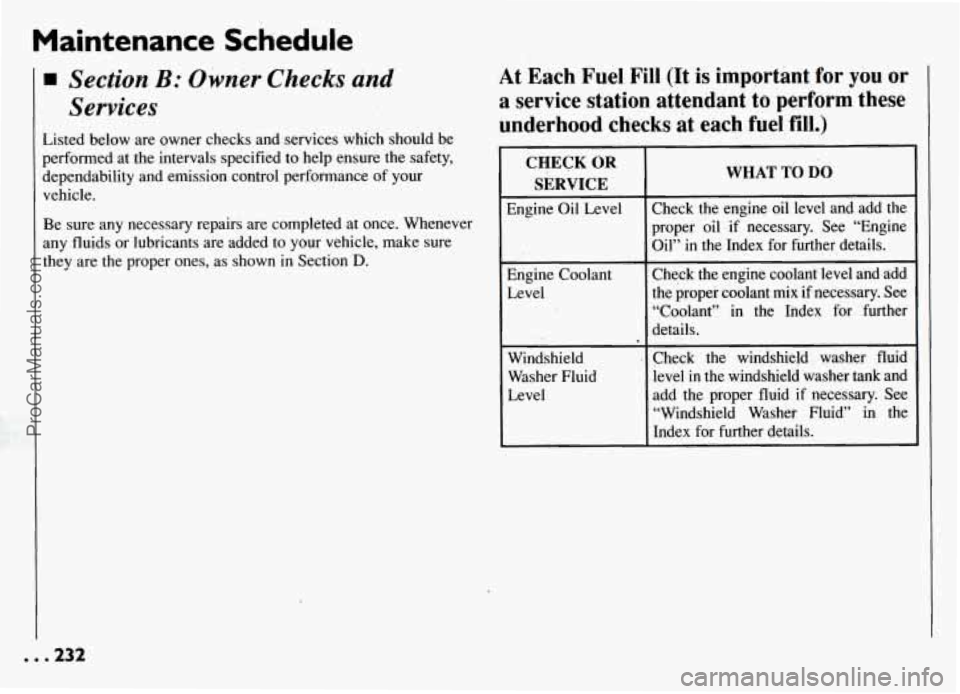
Maintenance Schedule
Section B: Owner Checks and
Services
Listed below are owner checks and services which should be
performed at the intervals specified to help ensure the safety,
dependability and emission control performance of your
vehicle.
Be sure any necessary repairs are completed at once. Whenever
any fluids or lubricants are added to your vehicle, make sure
they are the proper ones, as shown in Section
D.
At Each Fuel Fill (It is important for you or
a service station attendant to perform these
underhood checks at each fuel fill.)
CHECK OR
SERVICE
Engine Oil Level
Engine Coolant
Level
Windshield
Washer Fluid
Level
WHAT TO DO
Check the engine oil level and add the
proper oil
if necessary. See “Engine
Oil”
in the Index for further details.
Check the engine coolant level and add
the proper coolant mix if necessary. See
“Coolant” in the Index for further
details.
Check the windshield washer fluid
level in the windshield washer tank and
add the proper fluid
if necessary. See
“Windshield Washer Fluid” in the
Index for further details.
ProCarManuals.com